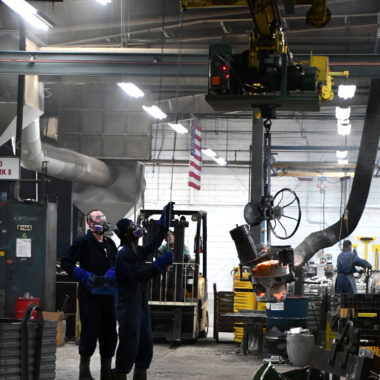Grasping Aluminum Casting: Proven Methods to Enhance Production Performance
Grasping Aluminum Casting: Proven Methods to Enhance Production Performance
Blog Article
Discovering the Numerous Techniques of Aluminum Spreading: A Comprehensive Guide
Aluminum casting stands as a basic procedure in the creation of many products we run into daily, from elaborate automotive elements to household components. Understanding the varied methods used in light weight aluminum casting is crucial for makers looking for precision and performance in their production procedures - aluminum casting. As we start this exploration of the numerous techniques entailed in aluminum casting, we reveal a world where advancement and practice converge to shape the items that shape our contemporary globe
Sand Spreading Technique
Making use of one of the oldest and most commonly made use of methods in light weight aluminum spreading, the sand spreading method includes developing molds from a mixture of sand and a binder product. This technique is extremely functional, affordable, and appropriate for generating a wide variety of sizes and shapes, making it a popular option in different markets.

Aluminum, warmed to its melting point, is after that poured right into the mold, loading the tooth cavity. After cooling and strengthening, the sand mold and mildew is broken away, disclosing the aluminum spreading. This method permits the production of intricate geometries and is well-suited for both reduced and high volume manufacturing runs.
Investment Casting Method
Having actually discovered the sand casting method, a refined technique to light weight aluminum spreading is the financial investment casting technique, which provides unique benefits in terms of accuracy and surface area coating. Financial investment spreading, also known as lost-wax casting, is a process that involves producing a wax pattern that is coated with a ceramic shell.
One of the primary benefits of investment casting is its capability to create complicated shapes with high precision and complex details. The process enables thin walls, sharp edges, and fine surface coatings that call for marginal post-processing. In addition, financial investment spreading is known for its excellent dimensional accuracy and limited resistances, making it a recommended approach for creating parts that require tight specifications. Overall, the financial investment spreading strategy is a flexible and efficient approach for manufacturing high-grade light weight aluminum elements.
Permanent Mold And Mildew Process

One of the key advantages of the Irreversible Mold Refine is its ability to create components with a finer grain structure, resulting in improved mechanical properties. By leveraging the Long-term Mold and mildew Refine, producers can accomplish cost-efficient production of aluminum components with excellent dimensional accuracy and surface coating.
Pass Away Casting Approach
In comparison to the Long-term Mold And Mildew Refine, the Die Casting Method for light weight aluminum casting involves using a recyclable steel mold and mildew to generate intricate get rid of high dimensional accuracy. This technique is extensively made use of in various industries because of its ability to successfully mass-produce intricate shapes with slim wall surfaces and superb surface finishes.
Die casting usually begins with the preparation of the steel mold and mildew, which is after that splashed with a lube to assist in the elimination of the strengthened light weight aluminum. The mold and mildew is shut, and molten aluminum is injected under high pressure into the cavity. Once the aluminum cools and solidifies, the mold and mildew opens up, exposing the finished part.
One of the key benefits of die spreading is its high manufacturing price, making it an economical option for massive manufacturing. Additionally, parts generated via die spreading display exceptional strength and resilience compared to those made via various other casting methods. This approach is particularly ideal for applications needing elaborate designs, limited resistances, and high repeatability.
Centrifugal Casting Method
Just how can the Centrifugal Casting Method boost the effectiveness and quality of light weight aluminum spreading processes? Centrifugal spreading is a technique that utilizes centrifugal pressure to distribute molten steel into a mold and mildew tooth cavity. This technique supplies a number of benefits over standard casting approaches.
One secret advantage is the remarkable quality of the spreadings produced. The centrifugal pressure helps to remove porosity by pushing any kind of gas or pollutants in the direction of the center of the spreading, leading to a denser and extra uniform last product (aluminum casting). In addition, the rotational motion of the mold and mildew guarantees discover here an extra even circulation of the liquified metal, bring about improved mechanical properties and decreased issues
The approach permits for the spreading of detailed forms and thin-walled components with convenience, increasing the layout opportunities for suppliers. In verdict, the Centrifugal Spreading Approach stands out as a reliable technique for enhancing both the efficiency and quality of light weight aluminum spreading procedures.

Conclusion
In final thought, the various techniques of light weight aluminum spreading supply distinct benefits and qualities for various applications. Sand casting offers convenience and cost-effectiveness, investment spreading permits elaborate layouts, permanent mold process makes sure high-quality surfaces, die casting supplies high production rates, and check out here centrifugal spreading generates high-strength elements. Understanding the differences in between these approaches can help manufacturers select one of the most ideal method for their certain spreading demands.
Having actually checked out the sand casting method, a polished strategy to light weight aluminum casting is the investment casting strategy, which offers unique benefits in terms of accuracy and surface area finish. Investment casting, additionally known as lost-wax casting, is a process that includes producing a wax pattern that is coated with a ceramic shell.How can the Centrifugal Spreading Method improve the efficiency and high quality of aluminum spreading procedures? In conclusion, the Centrifugal Spreading Technique stands out as a reliable strategy for enhancing both the performance and quality of light weight aluminum spreading procedures.
Sand spreading provides versatility and cost-effectiveness, financial investment spreading enables for complex styles, irreversible mold procedure makes certain high-quality finishes, pass away casting gives high manufacturing rates, and centrifugal casting produces high-strength parts.
Report this page